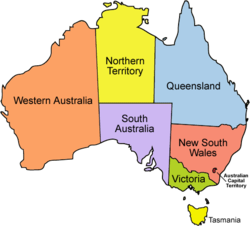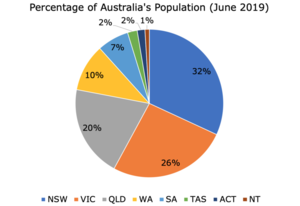Difference between revisions of "Australian State"
m |
(general expand/National Cabinet) |
||
| Line 1: | Line 1: | ||
{{concept | {{concept | ||
|wikipedia=https://en.wikipedia.org/wiki/States_and_territories_of_Australia | |wikipedia=https://en.wikipedia.org/wiki/States_and_territories_of_Australia | ||
| − | |image= | + | |image=Australia locator.png |
|constitutes=Australia | |constitutes=Australia | ||
| + | |description= | ||
}} | }} | ||
| − | + | [[image:Aus Population - States.png|thumb]] | |
| + | |||
| + | The '''states''' and '''territories''' are [[federation|federated]] [[administrative division]]s in [[Australia]] ruled by [[region]]al governments. The Federation of Australia constitutionally consists of six [[federated state]]s ([[New South Wales]], [[Queensland]], [[South Australia]], [[Tasmania]], [[Victoria (Australia)|Victoria]], and [[Western Australia]]) and ten [[federal territory|federal territories]], out of which two are run as de facto states (the [[Australian Capital Territory]] and [[Northern Territory]]). | ||
| + | |||
| + | States are [[self-governing]] [[polities]] with incomplete [[sovereignty|sovereignty]] (having ceded some sovereign rights to [[federation]]) and have their own [[constitutions]], [[legislature]]s, [[departments]], and certain [[civil authority|civil authorities]] (e.g. [[judiciary]] and [[law enforcement]]) that administer and deliver most [[public policy|public policies]] and programmes. | ||
| + | |||
| + | Each state of Australia is a successor to historical British colonies and each has its own state/territorial constitution. The [[Australian Capital Territory]] (ACT) and [[Northern Territory]] for the most part operate indistinguishably from the states, even though they do not have constitutional status as states. | ||
| + | |||
| + | The status and power of state and territory leaders have continued to rise through [[COVID-19]], and the [[good cop/bad cop]] tag team between state governments and the federal government was used to great effect to implement [[lockdowns]], [[Mandatory COVID-19 vaccination| mandatory vaccination]], internal border closings and other measures. | ||
| + | |||
| + | ==National Cabinet== | ||
| + | For the first 91 years after Federation on January 1 [[1901]], a forum known as the Premiers’ Conference existed. The first meeting between the prime minister and premiers was held in November [[1901]]. By the early [[1960s]], under the [[Robert Menzies|Menzies government]], premiers’ conferences had settled into a mostly regular schedule of twice-yearly meetings.<ref>https://theconversation.com/will-national-cabinet-survive-the-covid-opening-up-170631</ref> | ||
| + | |||
| + | An institution called the [[The National Cabinet]] was established at the beginning of the [[COVID deep event]], on 13 March [[2020]], a forum for the Prime Minister, Premiers and Chief Ministers to meet and work collaboratively.<ref>https://federation.gov.au/national-cabinet</ref> | ||
| + | |||
| + | Under the [[Freedom of Information Act]] (FOI) the public has access information relating to intergovernmental meetings. In August 2021 the federal government unilaterally, without asking Parliament to change the law, declared that National Cabinet to be part of the Federal Cabinet and as such exempt under the Cabinet secrecy exemption of the FOI Act. This was rejected by the Administrative Appeals Tribunal.<ref>https://www.modernaustralian.com/news/16931-morrison-government-loses-fight-for-national-cabinet-secrecy</ref> | ||
| + | |||
| + | In September [[2021]] the government introduced a law change to shield the National Cabinet from Freedom of Information requests, but it failed to go through Parliament.<ref>https://www.theguardian.com/australia-news/2021/sep/29/bill-to-exempt-national-cabinet-from-foi-in-doubt-after-liberal-senator-says-he-will-cross-floor</ref> | ||
{{SMWDocs}} | {{SMWDocs}} | ||
==References== | ==References== | ||
{{reflist}} | {{reflist}} | ||
| − | |||
Revision as of 08:52, 27 November 2021
(Australia) | |
|---|---|
 | |
The states and territories are federated administrative divisions in Australia ruled by regional governments. The Federation of Australia constitutionally consists of six federated states (New South Wales, Queensland, South Australia, Tasmania, Victoria, and Western Australia) and ten federal territories, out of which two are run as de facto states (the Australian Capital Territory and Northern Territory).
States are self-governing polities with incomplete sovereignty (having ceded some sovereign rights to federation) and have their own constitutions, legislatures, departments, and certain civil authorities (e.g. judiciary and law enforcement) that administer and deliver most public policies and programmes.
Each state of Australia is a successor to historical British colonies and each has its own state/territorial constitution. The Australian Capital Territory (ACT) and Northern Territory for the most part operate indistinguishably from the states, even though they do not have constitutional status as states.
The status and power of state and territory leaders have continued to rise through COVID-19, and the good cop/bad cop tag team between state governments and the federal government was used to great effect to implement lockdowns, mandatory vaccination, internal border closings and other measures.
National Cabinet
For the first 91 years after Federation on January 1 1901, a forum known as the Premiers’ Conference existed. The first meeting between the prime minister and premiers was held in November 1901. By the early 1960s, under the Menzies government, premiers’ conferences had settled into a mostly regular schedule of twice-yearly meetings.[1]
An institution called the The National Cabinet was established at the beginning of the COVID deep event, on 13 March 2020, a forum for the Prime Minister, Premiers and Chief Ministers to meet and work collaboratively.[2]
Under the Freedom of Information Act (FOI) the public has access information relating to intergovernmental meetings. In August 2021 the federal government unilaterally, without asking Parliament to change the law, declared that National Cabinet to be part of the Federal Cabinet and as such exempt under the Cabinet secrecy exemption of the FOI Act. This was rejected by the Administrative Appeals Tribunal.[3]
In September 2021 the government introduced a law change to shield the National Cabinet from Freedom of Information requests, but it failed to go through Parliament.[4]
Examples
| Page name | Description |
|---|---|
| New South Wales | Australia's most populous state |
| Northern Territory | Thinly populated Australian territory |
| Queensland | Large Australian northern state |
| South Australia | Australian state dominated by the Adelaide Establishment |
| Tasmania | Australian island state. |
| Victoria (Australia) | Australia's second most populous state - from 2020, a centre for implementing the COVID-19 agenda |
| Western Australia | Large Australian state isolated from the others by deserts |
References
- ↑ https://theconversation.com/will-national-cabinet-survive-the-covid-opening-up-170631
- ↑ https://federation.gov.au/national-cabinet
- ↑ https://www.modernaustralian.com/news/16931-morrison-government-loses-fight-for-national-cabinet-secrecy
- ↑ https://www.theguardian.com/australia-news/2021/sep/29/bill-to-exempt-national-cabinet-from-foi-in-doubt-after-liberal-senator-says-he-will-cross-floor
